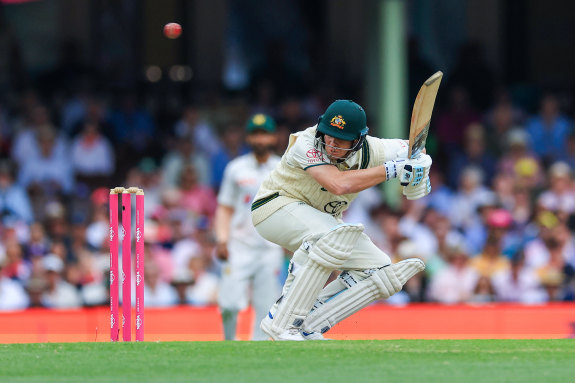This was published 1 year ago
Like Bradman, Smith seeks a way out of bouncer barrage
Steve Smith flew into Adelaide on Saturday night to start his new life as a Test opener, seeking an escape from the same cycle of short balls and negativity that Don Bradman confronted at the height of Bodyline in the same city more than 90 years ago.

Steve Smith ducks a bouncer in the SCG Test.Credit: Getty Images
At the end of the series, Bradman confessed to a sense of relief that it was over. He yearned to get back to “normal cricket”, where a Test average of 99.94 will tell you Bradman reigned supreme.
“It was something that was not going to last,” he said in later years. “It only had a limited life, and we were all very relieved when the season was over, and we got back to normal cricket again.”
That same yearning for “normal cricket” has compelled Smith to open the batting for Australia, as he seeks a way out of the cycle of short balls, negative tactics and slow scoring. Bradman was afflicted for just one series, but it has been Smith’s lot for four years, chipping away at his average by pulling back his strike rate.
At the end of the 2019 Ashes, Smith appeared virtually impossible to dismiss. He had piled up 774 runs in four matches in difficult conditions to be the single biggest factor in Australia’s retention of the urn, and left bowlers around the world scratching their heads for a solution.
Enter Neil Wagner, the New Zealand left-armer of great hostility and stamina, to target Smith with a barrage of short balls. It was no great spectacle, but Wagner’s line of attack succeeded in curbing Smith’s scoring and getting him out now and then.
“There’s no point pitching it up and swinging it when he hasn’t been out lbw or bowled that many times,” Wagner explained during the series. “He doesn’t get caught behind in the slip many times and when he does, where do you put fielders? He hits through point; he hits straight down the ground – we had to find a different way. The way he sets up it sort of feels like [short bowling] is a way to dot him but also a chance to get him out.”
It is not as though bowlers have solely been targeting Smith with short stuff ever since, but there has been enough of it to put doubts in his mind where previously there were none. England stacked the leg side during last year’s Ashes, Pakistan the off side during the series just completed. Short balls dismissed Smith on occasions in both.
Moreover, by often coming in behind big innings from Marnus Labuschagne and Usman Khawaja, Smith has lost the sense of centrality to proceedings that helped take him to such great heights in 2019.
David Warner, having played his final Test at the SCG earlier this month and hugged Smith on his way off the field for the last time, went as far as to say that he felt the former captain had become “bored” with the combination of waiting long hours to bat, only to face negative opposition tactics when he does.
“I probably think he’s bored at No.4 and he wants to have a hit and not wait,” Warner told Fox Cricket. “People have been bowling short to him when he first gets in. But he finds a way.
“Early on, they’re going to try and swing the ball and pitch the ball up. And he’s going to be allowed to get into his game and his game plan. Get into the rhythm of how he wants to bat and he can dictate. So I’m actually looking forward to seeing how he goes.”
There is another possible factor, too. Earlier last year, around the time of the tour of England, Cameron Green changed management stables, signing up with Warren Craig as his agent. Craig, who had got to know Green’s father via basketball carnivals, is also the longtime manager of Smith.
In his explanations for making the move, Smith has spoken as much about wanting to give Green an opportunity in the batting spot he had occupied so dominantly for Western Australia as he has discussed his own game. This is not to say that manager Craig pulled the strings, only that Smith has been placed closer to Green’s orbit at the same time as the openers debate evolved.
“There’s been conversations happening for a little while, obviously, knowing that Davey was going to finish up after Sydney,” Smith said on Friday night. “I know they were keen to get Cameron Green back into the fold as well. And yeah, for me, it was just a conversation saying, look, I’m keen to go at the top.

Steve Smith enjoyed a bumper 2019 Ashes series when arriving at the crease early.Credit: Getty Images
“If you’re thinking about Greeny up the top, he hasn’t done it much or he hasn’t done it at all. He bats No.4 in Shield cricket. And, you know, since I guess Marnus has been playing at No.3, I’ve been waiting to bat for quite a long period of time and I don’t really like waiting to bat.
“So I thought why don’t I put my hand up and have a crack up top and that way you can get Cameron Green in and you’re playing your six best batters? So yeah, hopefully it works out.”
Undoubtedly, Smith believes that by making his move he can return to the centre of the action more often. A glance at the scores when he came into bat during the aforementioned 2019 Ashes series provides a potent reminder of the tension he is chasing.
At Edgbaston, Smith arrived at 2-17 in the eighth over then 2-27 in the 10th over. At Lord’s he got more of a start, 2-60 in the 23rd over, before concussion ruled him out of the second innings. Manchester had Smith arriving at 2-28 and 2-16, each in the seventh over. The Oval? 2-14 in the sixth over and 2-29 in the seventh.
“I like facing the newer ball,” Smith said. “I think if you look back to the 2019 Ashes I was in pretty early most of the time there where I was facing the new ball.
“I batted No.3 for a number of years as well and was in early and did pretty well against the new ball so it’s nothing new or foreign to me. You know I enjoy getting in there and getting amongst it.”
Of course, new-ball bowlers are only inclined to pitch up to Smith if they stick to convention. At the SCG on Friday night, Daniel Sams dropped his very first ball short, and Smith top edged a hook to long leg. West Indies will get the first chance to try something similar this week.
Sports news, results and expert commentary. Sign up for our Sport newsletter.